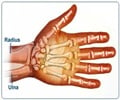The Wonder Rays
Roentgen discovered X-rays in 1895 when he was performing a physics experiment. He found out that the rays coming out of the tube could penetrate substances like cardboard. He tried stopping these rays with his hand, by placing in-between the tube and the screen and to his amazement, he could see an image of the bones of his hand. Fluoroscopic images of his wife’s hand, showing their wedding ring and revealing the underlying bones became very popular then. Roentgen was awarded Nobel Prize for his discovery in 1901.
The rays were represented with a specific symbol, X meaning unknown because he could not understand where and how the rays originated from. With our improved understanding of physics and radiation, it is now known that X-ray is a form of electromagnetic radiation. X-rays are in a way similar to the rays from the sun, which enables visualization, and heat up the object on which they fall. X-rays however, have some special characteristics that enable its use in diagnosis and medicine.
X-rays have high energy and can therefore penetrate through skin and muscle. It is absorbed by dense tissues such as cartilage and bone that produces an image of the skeleton on a photographic film.











